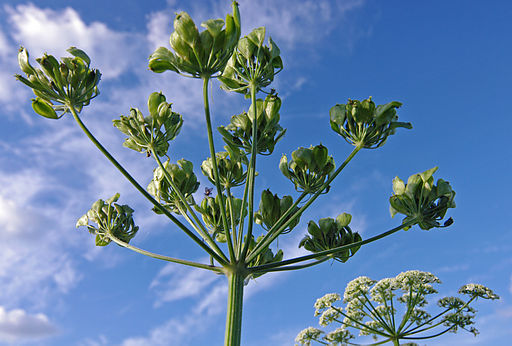The seeds of the common hogweed make a wonderful spice or flavouring, they are mostly gone by now but a few can still be found clinging to their dead and dry stems.
To make best use of them you will need to collect several hand full's, the easiest way is just to pull the whole seed head off in one go. Once you have them you need to grind them up, you could use a pestle and mortar, or just a rock, as you start to crush them blow gently on them to get rid of as many of the papery seed casings as possible, just don't blow too hard or you will loose all the good stuff too.
 |
| The foliage of a young hogweed plant |
The resulting spice can then be stored for later use or used there and then, they have a gingery/cardamom type flavour and go exceptionally well in biscuits, cakes, stir frys and currys.
Rather than giving you a full recipe for any of these things here what I would suggest is that anything you would normally use ginger in you can use hogweed instead, for example if you substitute the ginger in your recipe for ginger bread with about twice as much hogweed you will get a delicious spicy biscuit.
Students cooking hog weed biscuits on spades over a fire
You can also use the seeds when they are green as a spice or pickled as a substitute for capers.

Christian Fischer [CC-BY-SA-3.0], via Wikimedia Commons
Do make sure that you don't confuse hogweed with it's non native relative the giant hogweed, it looks very similar but as the name implies it's gigantic by comparison. Although the stem retains the ridged and hairy characteristics of the common hogweed, the giant hogweed's stem can be up to five centimetres thick and is often redish in colour. The leaves are also more deeply and sharply serrated. It has been planted as an ornament in the past but is now classed as a non native invasive species. The problem is that it's sap is extremely phototoxic, areas of the body affected by the sap can develop photodermititis which means blisters and burning will develop when the affected areas of the skin are exposed to sunlight.
Other plants you may mistake for hogweed include some of the other umbelifers (plants with umbrella shaped sprays of whitish flowers) such as hemlock, hemlock water dropwort and cowbane, these species though are easily distinguishable by their much smaller black seeds and leaves which more closely resemble the leaves of carrot. Again though the extreme toxicity of these species serve as a reminder that you must be 100% certain about what it is you are eating.




No comments:
Post a Comment
Note: only a member of this blog may post a comment.